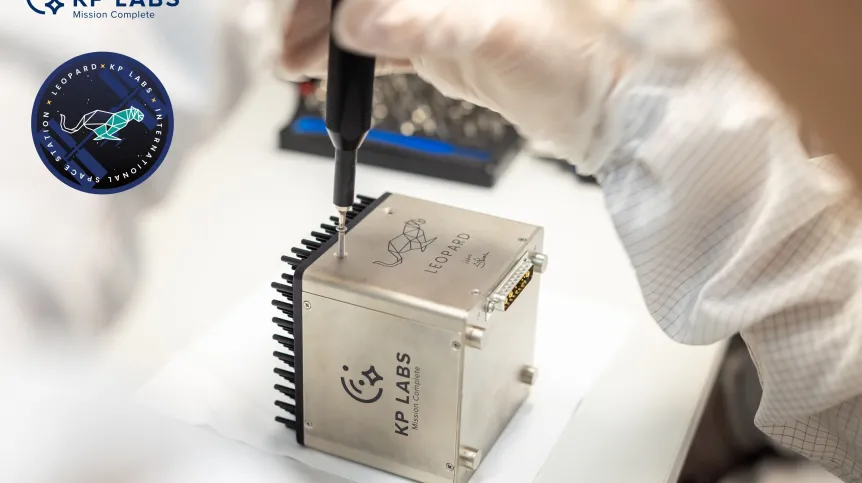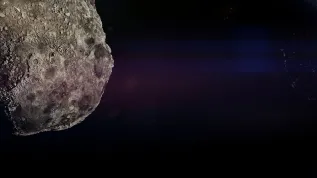
Data processing in orbit and the possibility of 'connecting' many applications are the main assumptions of the 'LeopardISS' experiment. The brain of the entire system is a compact data processing unit measuring approx. 10x10x10 cm, which has already arrived at the ISS and is now waiting for the crew of the Polish mission.
'LeopardISS" is one of 13 experiments as part of the Polish technological and scientific mission IGNIS to the International Space Station (ISS). Although the launch of the Ax-4 crew - with the Polish European Space Agency (ESA) project astronaut Sławosz Uznański-Wiśniewski - will take place on May 29, in this case the device was sent on an earlier flight. The unit has already arrived at the ISS, where it is waiting for the Ax-4 crew to arrive and start the experiment.
The device itself is inconspicuous, a small cube with a side of approx. 10 cm, in an aluminum housing. Its main component is the Leopard data processing unit. 'It is a tiny thing, but it has a large memory and it is capable of running the most advanced artificial intelligence algorithms', emphasises Dawid Lazaj from KP Labs in Gliwice.
'Artificial intelligence algorithms are crucial here, because they enable the autonomy of data processing in orbit', he adds.
He explains that during communication sessions (i.e. when, during its movement in orbit, the satellite is within the range of transmitters from a given place on Earth), the computer can be instructed to process data or sets of data stored in its memory. 'Then, when we lose sight of the satellite, the computer processes these data and we get the result during the next communication session. We have a dozen or so such sessions during the day, and the break between them lasts about an hour and a half', he explains.
According to Dawid Lazaj, this approach to transferring a significant part of data processing to orbit, and to a certain degree of computer autonomy is crucial for the development of space technologies.
'This is because more and more data are being generated in orbit, and in addition cameras and sensors are getting better and better, and therefore images are getting larger, which poses a huge challenge when it comes to sending them to Earth. The bandwidth of the connection is growing of course, but disproportionately to the amount of data generated in orbit. Hence this trend', he says.
It is also economical, because while the satellite is orbiting out of range, the computer cannot be instructed to do anything, and in this way, trained by machine learning algorithms, it will be able to 'use' this time, for example, to analyse the quality of the images (and delete those with clouds obscuring the view of the Earth's surface), or to reduce their size.
The data processing unit used in the experiment during the IGNIS mission is not a new development. The Polish satellite Intuition-1 equipped with Leopard has been in orbit since November 2023; it is still operating and transmitting data. 'It is the same component, i.e. the same data processing unit. We did not want to interfere with it too much to show that it is modular and can be expanded', Dawid Lazaj says.
A small but significant change, however, is that in the case of LeopardISS there is no preinstalled permanent software, instead users can remotely 'connect' additional applications to it.
The first such tested application will be the Poznań University of Technology project for mapping 3D images for the needs of planetary rover missions.
If the tests are successful, in the future the LeopardISS computer could be permanently located on the International Space Station, and various entities would be able to temporarily 'upload' their applications to it in order to collect research or observation data - without having to have their own hardware.
According to Dawid Lazaj, the computer is expected to work for 180 days in operational mode, 'so even if there is some downtime, the days of operation count'.
'LeopardISS' is already on the International Space Station, where it is waiting for the crew of the IGNIS mission. Dawid Lazaj explains that the role of the astronauts will be to connect the cube to the equipment that belongs to the Belgian company ICE Cubes Service. Once it is connected, it will be possible to run the application.
Lazaj says that when it comes to the technology of data processing on orbit, the solutions of KP Labs are not the only ones. 'But we are distinguished by this very compact unit', he emphasises. He also reminds that the Polish space sector company KP Labs already has experience and cooperates with the European Space Agency (ESA), among others.
The Ax-4 crew members are Peggy Whitson (USA) - commander; Sławosz Uznański-Wiśniewski (Poland/ESA) - specialist; Shubhanshu Shukla (India) - pilot and Tibor Kapu (Hungary) - specialist. The astronauts will spend 14 days on the International Space Station.
The Ax-4 mission will be a commercial crewed expedition carried out by Axiom Space. The Pole's participation in this mission is the result of an agreement signed between the Polish Ministry of Development and Technology and the European Space Agency (ESA) to prepare and conduct the Polish scientific and technological mission IGNIS. The Polish Space Agency (POLSA) is also involved in the preparations as the executive agency of the Polish Ministry of Development and Technology.
Sławosz Uznański-Wiśniewski will be the second Pole in space.
Agnieszka Kliks-Pudlik (PAP)
akp/ bar/ mhr/













